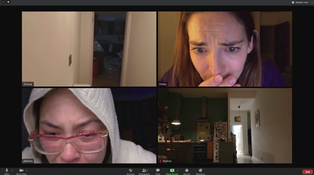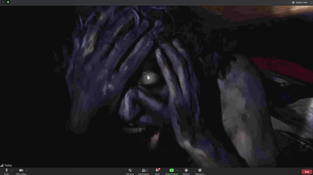Host (2020)
- nickkarner
- 1 day ago
- 6 min read

While watching the assured, fleet-footed, and pandemic-based Host (2020) by director/co-writer Rob Savage, I was reminded of films from the first half of the 20th century. Films which barely clocked in at 70 minutes and were often a part of double, even triple-feature bills. There was a time when it was perfectly acceptable for a film to barely stretch above an hour and still be regarded as a feature-length film. Nowadays, with the exception of animated features, the bare minimum length for a live action hovers somewhere between 75 and 80 minutes. It’s a case-by-case basis, but that’s the generally-accepted time frame. Still, with COVID-19 changing how we do EVERYTHING on the planet, including making movies, could a trend of super-short features have been on the way? Apparently not. They're still long. As a sometime-filmmaker myself, I’ve often gotten frustrated when a first or second cut has runtime 30 or 40 minutes, a no-man’s-land for film festivals where you either need to cut over to realistically get accepted into the short film competition, or double the runtime considerably. With the advent of Shudder and movies created exclusively for internet release, the concept of the micro-feature doesn’t seem out of the question.

The timeliness of Host’s concept couldn’t be more appropriate. In those uncertain times, Savage and co-writers Gemma Hurley and Jed Shepherd used our own isolation and anxiety against us. The need for connection and a break from the utter boredom coming from the quarantine spurs the ensemble cast to explore the initially fun notion of an online séance only to have things go terribly, terribly wrong. The semi-improvisatory nature coupled with a masterful use of practical and (mostly) subtle digital effects makes the proceedings feel all the more real and terrifying. There are jump scares galore and the lack of music, a key decision, enables Savage and co. to use random bangs and knockings to up the tension and suspense to an almost unbearable level.

Any film that makes a Simpsons reference right off the bat is OK by me. It’s obvious both I, Hans Moleman, and Rob Savage were saying Boo-Urns in the back row since that’s the name he gave his production company for the release of Host. His girlfriend even designed the logo in Animal Crossing. Ah, innovation. The actors, using their real names, have a natural chemistry and the dialogue has a breezy, conversational quality. Fortunately for the film’s dramatic element, each performer, particularly the main actresses, have genuine film experience, as opposed to a bunch of friends getting together to make a little movie on Zoom. A few of the performers are a bit on the interchangeable side while the most dynamic actresses are obviously helped by character-based writing.

The de facto leader is Haley (Haley Bishop), who sets up the séance and wants everyone to take everything deadly serious. She’s basically that friend who shows you a movie and expects, née demands that you react appropriately to everything happening onscreen. The other alpha has to be Jemma (Jemma Moore), your classic example of a wiseass who finds all of this spirit malarky ridiculous and silly. The rest of the cast is filled out by Emma (Emma Louise Webb), a pigtail-wearing fun girl, Caroline (Caroline Ward), somewhat nervous about messing about with the ghosts, and Radina (Radina Drandova), whose relationship with her in-isolation boyfriend is getting a bit tense. Making a brief appearance is the boisterous Teddy (Edward Linard), whose girlfriend can’t get enough of him and ends up forcing him off the video chat. Finally, we have the medium, Seylan (Seylan Baxter), an older woman who seems nice but absolutely earnest about doing her first online séance right.
There’s a good level of jocularity as Jemma and especially Teddy take shots every time Seylan says “astral plane.” They’ve lit candles, brought their items that will help them connect with the spirits, and are instructed to imagine holding hands and “visualize a circle.” Clever touches like early scenes of doors creaking open or weird noises act as fake-outs which are later paid off as a malevolent demon begins to wreak havoc on its unsuspecting victims. While I’m not a believer in spooky ghost worlds and “the other side,” although I’ve seen Poltergeist II and I’d say that makes me an expert, I still think it’s best not to mess around with things you aren’t 100% positive about. Unfortunately, Jemma thinks she’s hilarious and makes up an entire story about something grabbing her neck and a friend who committed suicide. We get a great and ironic moment when Seylan hears a mysterious knock on her end, only for it to turn out to be a delivery. It comes off as deeply embarrassing for the medium, but soon her internet cuts out and the women are left on their own.
Scary is scary. Period. And this film delivers some pretty creepy moments. The film builds to a crescendo with effective and simple effects. Haley’s chair gets shoved away from her computer. There's a bit more knocking and some light flickers. Cupboards are yanked open. Basic stuff. Caroline pops her phone on a selfie stick and checks out her attic, always a bad decision, and like in the excellent REC, we get a slow pan around a dark attic and something turns out to be there, in this case a pair of pale, spindly legs, although this time it disappears. Jemma gets a satisfying comeuppance of-sorts when Seylan comes back via phone and informs them that Jemma’s bad joke may have summoned a demon who wants nothing more than to terrify and possibly kill them all.
It’s a fabulous twist which places the blame solely on Jemma for what amounts to fooling around with things she doesn’t understand. One thing you shouldn’t do is “disrespect the spirits.” There’s a hint or two that the demon may or may not have been hanging around Haley due to the weird, distorted noises she hears earlier, but it’s up for interpretation. Jemma’s prank allowed some kind of portal to be opened and “anything can come through.” All of this ludicrous dialogue is delivered very well by Baxter, who seems to genuinely believe in what she’s saying and lends gravitas to what amounts to a literal haunting. Savage has explained that the probable demon, a Tulpa, is created through “group think.” In effect, the idea of a “hanged man,” which Jemma puts in everyone’s mind, essentially causes everyone to manifest the demon in their minds and bring it into existence.

Things quickly go to hell as each woman has her own terrifying experience. A floating face appears and we get a highly amusing and absolutely plausible joke where they think someone hasn’t turned off their effects filter. Powder is thrown about to try and suss out whether an invisible being is in the room. Radina’s boyfriend’s lifeless body slams down onto the floor from above. She attempts to flee but gets dragged across the hallway and then lifted high in the air and dropped, a bloody stain left on her screen. In what’s probably the scariest scene, Caroline’s background, which had been joked about earlier as it’s simply a video of her getting ready for bed, begins to play, causing the rest to believe she’s fine. However, things are not what they seem and the relative tranquility of her video is intermittently broken as the real Caroline is slammed repeatedly into her computer screen, leaving her face a pulpy, bloody mess. Haley is dragged out of her room and Jemma dons her mask and rushes to her aid. Meanwhile, Emma throws a sheet at her door, discovering the invisible entity, so she attempts to run but is thrown off her balcony and smashes through her outdoor table. Teddy returns with a creepy clown and receives an extremely unpleasant end. His girlfriend is lifted into the air and has her neck broken while he’s burned alive by the lighter he was using after his flashlight konked out. In a brief cutaway, we see an ominous noose right before Teddy dies.
Jemma breaks into Haley’s apartment and gets smacked in the head by an unknown object. Finding Haley, they attempt to light their way out by using Haley’s polaroid camera. The film subverts expectations by refusing to follow the “rule of three’s” and goes for four flashes before a monstrous creature (James Swanton) lashes out at the camera. The film ends with a listing of everyone on the Zoom chat. It’s odd and apparently was a way to show who worked on the film, but I wish it ended with the attack since a more traditional credit sequence immediately follows.
Films like Paranormal Activity and Searching proved that production values could be low but effective and an entire film could be depicted on a via small screen. Host is awesomely unpretentious and a prime example of what can come about when frustration is combatted by creativity.





































Commentaires